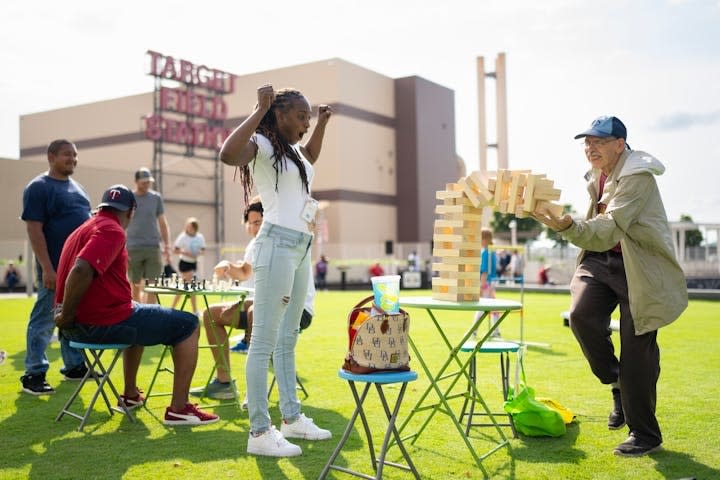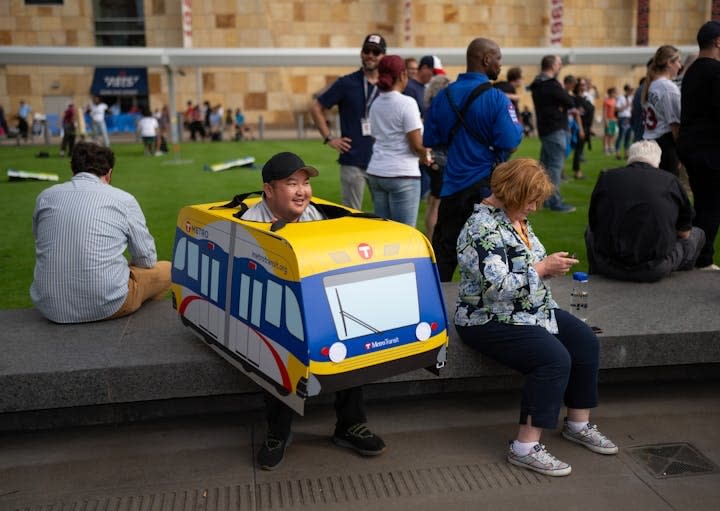Happy birthday, Metro Transit light rail
Metro Transit's much-maligned Blue and Green light-rail lines haven't seen this much love for quite some time.
As the Blue Line celebrates its 20-year anniversary this month, and the Green Line its 10th, light-rail enthusiasts gathered for a celebration at Target Field station Tuesday amid steamy weather conditions. Gov. Tim Walz even declared it "Light Rail Day" in Minnesota.
Passengers have taken nearly 280 million rides aboard light rail since the Blue Line began service in 2004. The addition of light-rail has transformed the Twin Cities' public transportation network, encouraged millions of dollars in nearby development, and spurred extensions of both lines, as well as the addition of five bus-rapid transit lines, with more planned.
"Light rail is a key part of our transit system and part of a thriving region," said Metro Transit General Manager Lesley Kandaras.
But light-rail service continues to be challenged by crime, the perception of crime, drug use and erratic behavior aboard trains and at stations — issues Metro Transit is battling with a multipronged strategy.
Ridership hollowed out once COVID-19 struck. The rise in remote work during the outbreak forever changed commuting patterns, and the system has never fully regained its pre-COVID ridership.
Blue Line average daily ridership between downtown Minneapolis and the Mall of America reached about 11 million before COVID hit. After a 63% drop in 2020, ridership climbed back to 6.5 million last year.
The Green Line's ridership between downtown Minneapolis and St. Paul has consistently outperformed its sister line, reaching 14 million riders in 2019. Last year, some 8 million people took the Green Line, the workhorse of the region's transit system.
In the wake of all this, the $2.9 billion Southwest light rail project, an extension of the Green Line linking Minneapolis to Eden Prairie, is nearly a decade behind schedule and more than $1 billion over budget. This has prompted an ongoing probe by the state's Legislative Auditor.
Meanwhile, planning for the $3 billion Blue Line extension between Minneapolis and Brooklyn Park continues to hum along after its route was changed three times. Last week, a key plan detailing how the project will affect neighborhoods, businesses and the environment was released for public comment.
Given these issues, light rail in the past 20 years has turned into one of the most-divisive issues in the state, with supporters saying it's an economic lifeline and detractors calling it a dystopian nightmare.
New development
Beyond providing a new mode of transportation, the Green and Blue lines helped spur a spate of new building in their wake, according to Metro Transit officials.
Between 2009 and 2022, building permits worth more than $44 billion have been issued for multifamily residential, commercial, public and institutional, and industrial developments throughout the metro, according to the Metropolitan Council. Of those developments nearly $11 billion are within a half mile of a light-rail station.
When asked whether light rail spurred development, Metro Transit's Senior Manager of Transit Oriented Development Michael Krantz is careful to say it helped but wasn't the sole impetus.
"If you talk to [real estate] developers along these corridors, most of them say they were absolutely attracted to light rail investment and that it improves the success of their project," Krantz said.
"In general, there's a lot more demand from folks wanting to live in walkable neighborhoods, with access to transit," he said.
A surge of development along the Blue Line wasn't expected at first.
Planners had predicted the areas surrounding the Blue Line route would draw 7,000 new housing units by 2020. But between 2009 and 2020, more than 15,000 new housing units were permitted, Krantz said.
Krantz noted the attention paid to crime and nuisance issues and the pandemic dampened development demand along both light-rail routes. He referred questions to city officials on whether St. Paul's rent-control ordinance quelled enthusiasm for development.
All told, Krantz said more new housing was built along the lines in 2022 than any previous year. "It was the most successful year for new development," he said.
Creeping westward
In contrast, the Green Line was built with real estate development firmly in mind, said Sue Haigh, a former Ramsey County commissioner and chair of the Met Council.
"We learned with the Blue Line running along Hiawatha [Avenue] there wouldn't be the same opportunities for development," Haigh said this week. Because the Green Line runs largely along University Avenue, through the "urban core," the opportunities for real estate investment were vast, she added.
The thinking among transit planners was that development along the Green Line would start on its western flank and creep eastward, which is generally what happened, particularly near the University of Minnesota, and the Prospect Park, Westgate and Raymond stations.
But there remains some prominent, unsightly gaps along the way, including the swath of pavement near Allianz Field in St. Paul, near the Snelling Avenue Green Line stop.
After an eight-year wait, a $100 million effort called United Village led by former UnitedHealth Group CEO Bill McGuire will begin this month with a new playground opening. The 34-acre site will ultimately feature office buildings, a hotel and a restaurant pavilion.
Krantz said the challenge in the future will be "finding good sites. A lot of the easy sites have been developed."
Some remaining may have contamination issues, or complicated property rights requiring builders to navigate regulations and zoning variances. High construction costs and interest rates complicate matters, too, he said.
But Met Council Chair Charlie Zelle is bullish about the future of light rail: "There's so much more success to come."


